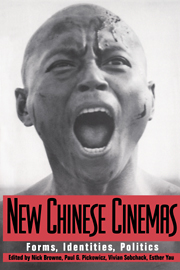Book contents
- Frontmatter
- Contents
- List of Illustrations
- List of Contributors
- Acknowledgments
- Note on the Romanization of Chinese
- Introduction
- I FILM IN THE PEOPLE'S REPUBLIC
- 1 Spatiality and Subjectivity in Xie Jin's Film Melodrama of the New Period
- 2 Society and Subjectivity
- 3 Huang Jianxin and the Notion of Postsocialism
- 4 Neither One Thing nor Another
- II FILM IN TAIWAN AND HONG KONG
- Chronologies
- Glossary
- Scholarly Works on Chinese Filmmaking in the 1980s
- Index
4 - Neither One Thing nor Another
Toward a Study of the Viewing Subject and Chinese Cinema in the 1980s
Published online by Cambridge University Press: 05 June 2012
- Frontmatter
- Contents
- List of Illustrations
- List of Contributors
- Acknowledgments
- Note on the Romanization of Chinese
- Introduction
- I FILM IN THE PEOPLE'S REPUBLIC
- 1 Spatiality and Subjectivity in Xie Jin's Film Melodrama of the New Period
- 2 Society and Subjectivity
- 3 Huang Jianxin and the Notion of Postsocialism
- 4 Neither One Thing nor Another
- II FILM IN TAIWAN AND HONG KONG
- Chronologies
- Glossary
- Scholarly Works on Chinese Filmmaking in the 1980s
- Index
Summary
Emphasizing the unfinishable qualities of this essay is fundamental to what I want to communicate about Chinese film and social change in the 1980s. I have come to the conclusion that Chinese film and social change in the 1980s does not constitute an object; it is too complex, too contradictory, too dynamic, and too chaotic to be isolated and described. The impossibility of this project does not mean, however, that film and social change in the 1980s is beyond understanding. Rather, it means that what is to be understood is precisely its refusal to be one thing or another, and precisely how it refuses to be one thing or another, and I can best communicate these qualities by tracing my own failed efforts to pin it down as an object.
The Classical Viewing Subject
When I first began this project, its impossibility was not apparent to me. Indeed, I had produced a paradigm for the relationship between mainland cinema and society between the 1949 Liberation and the late 1970s, and felt that I might be able to adapt and extend this work in some way to the 1980s. In that earlier work, I used the term “classical Chinese cinema” to refer to the variety of socialist realist filmmaking dominant throughout the period in question and analyzed the way in which this cinema positions the viewer, with particular reference to gender.
- Type
- Chapter
- Information
- New Chinese CinemasForms, Identities, Politics, pp. 88 - 114Publisher: Cambridge University PressPrint publication year: 1994
- 3
- Cited by



